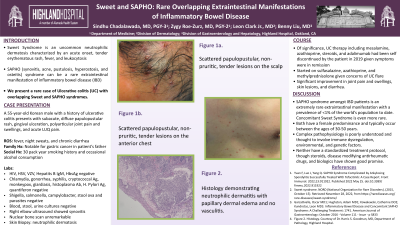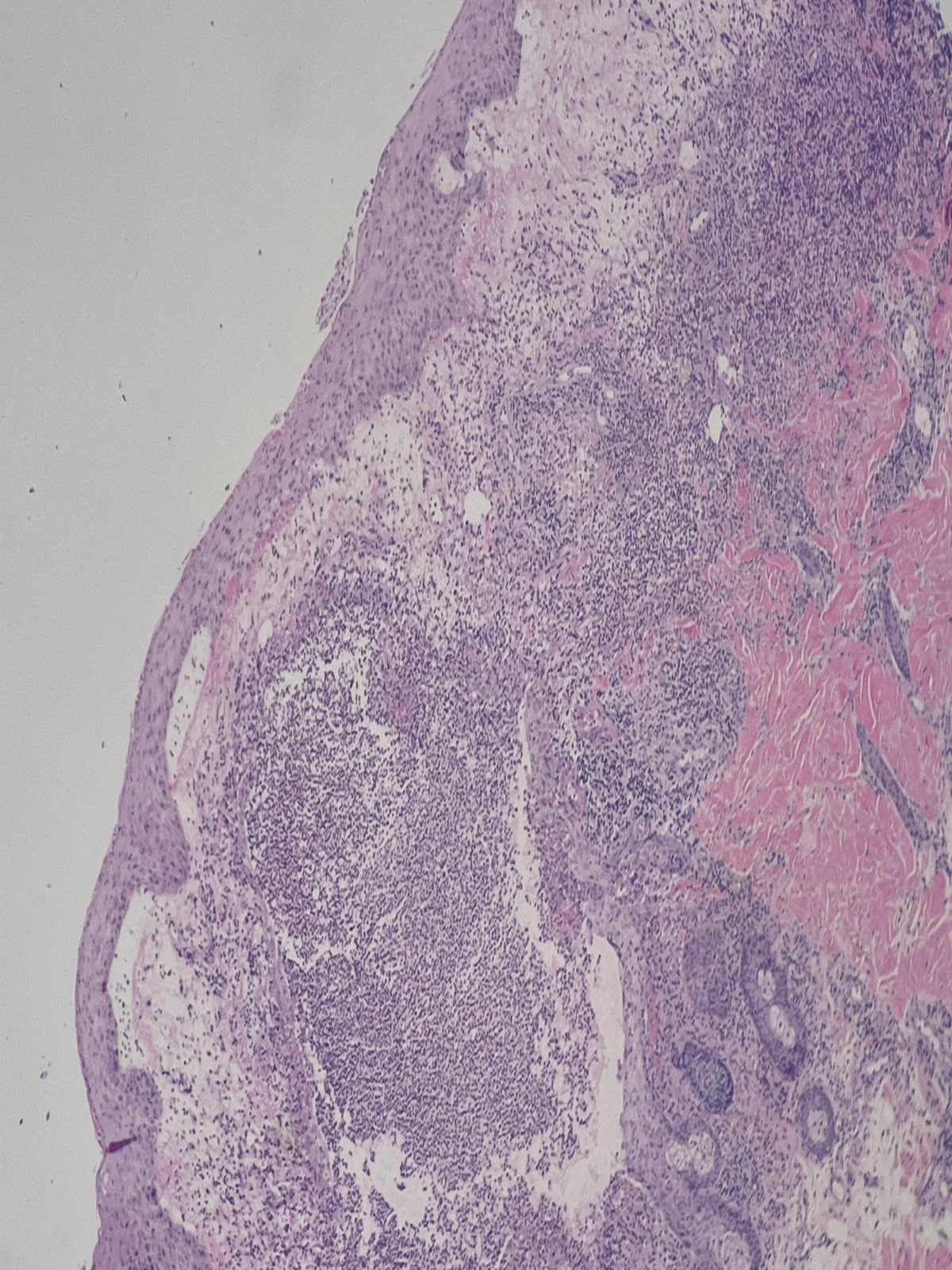Monday Poster Session
Category: IBD
P2236 - Sweet and SAPHO: Rare Overlapping Extraintestinal Manifestations of Inflammatory Bowel Disease
Monday, October 23, 2023
10:30 AM - 4:15 PM PT
Location: Exhibit Hall

Has Audio

Sindhu Chadalawada, MD
Alameda Health System - Highland Hospital
Oakland, CA
Presenting Author(s)
Sindhu Chadalawada, MD1, Zygy Roe-Zurz, MD1, Leon Clark Jr., MD2, Benny Liu, MD1
1Alameda Health System - Highland Hospital, Oakland, CA; 2Alameda Health System - Highland Hospital & Eastmont Wellness Center, Oakland, CA
Introduction: Sweet Syndrome is an uncommon neutrophilic dermatosis characterized by an acute onset, tender erythematous rash, fever, and leukocytosis. SAPHO (synovitis, acne, pustulosis, hyperostosis, and osteitis) syndrome can be a rare extraintestinal manifestation of inflammatory bowel disease (IBD). We present a rare case of Ulcerative colitis (UC) with overlapping Sweet and SAPHO syndromes.
Case Description/Methods: A 55-year-old Korean male with a past medical history significant for ulcerative colitis presents with subacute, diffuse papulopustular rash, gingival ulceration, polyarticular joint pain and swellings, and acute LUQ pain. Review of systems was significant for fever, night sweats, and chronic diarrhea. Family history was notable for gastric cancer in the patient’s father. Social history remarkable for a 30-pack year smoking history and occasional alcohol consumption. Of note, all UC therapy including mesalamine, azathioprine, steroids, and adalimumab had been self-discontinued by the patient in 2019 given symptoms were in remission. Infectious workup including sexually transmissible diseases, hepatitis, tuberculosis, monkey pox, giardiasis, herpes simplex virus, varicella, blood and urine cultures were unremarkable. Ultrasound of right elbow revealed synovitis, however, subsequent nuclear bone scan was unrevealing. Diagnosis of SAPHO was made given osteoarticular disease noted by synovitis as well as presence of pustulosis and acne. Skin biopsy was also pursued and demonstrated a neutrophilic dermatitis consistent with Sweet syndrome. The patient was started on sulfasalazine, azathioprine, and methylprednisolone given concerns of UC flare with significant improvement in joint pain and swellings, skin lesions, and diarrhea.
Discussion: SAPHO syndrome amongst IBD patients is an extremely rare extraintestinal manifestation with a prevalence of < 1% of the world’s population to date. Concomitant Sweet Syndrome is even more rare. Both of these disorders have a female predominance and typically occur between the ages of 30-50 years. Their complex pathophysiology is poorly understood and thought to involve immune dysregulation, environmental, and genetic factors. As a result, neither have a standardized treatment protocol, though steroids, disease modifying antirheumatic drugs, and biologics have shown good promise.

Disclosures:
Sindhu Chadalawada, MD1, Zygy Roe-Zurz, MD1, Leon Clark Jr., MD2, Benny Liu, MD1. P2236 - Sweet and SAPHO: Rare Overlapping Extraintestinal Manifestations of Inflammatory Bowel Disease, ACG 2023 Annual Scientific Meeting Abstracts. Vancouver, BC, Canada: American College of Gastroenterology.
1Alameda Health System - Highland Hospital, Oakland, CA; 2Alameda Health System - Highland Hospital & Eastmont Wellness Center, Oakland, CA
Introduction: Sweet Syndrome is an uncommon neutrophilic dermatosis characterized by an acute onset, tender erythematous rash, fever, and leukocytosis. SAPHO (synovitis, acne, pustulosis, hyperostosis, and osteitis) syndrome can be a rare extraintestinal manifestation of inflammatory bowel disease (IBD). We present a rare case of Ulcerative colitis (UC) with overlapping Sweet and SAPHO syndromes.
Case Description/Methods: A 55-year-old Korean male with a past medical history significant for ulcerative colitis presents with subacute, diffuse papulopustular rash, gingival ulceration, polyarticular joint pain and swellings, and acute LUQ pain. Review of systems was significant for fever, night sweats, and chronic diarrhea. Family history was notable for gastric cancer in the patient’s father. Social history remarkable for a 30-pack year smoking history and occasional alcohol consumption. Of note, all UC therapy including mesalamine, azathioprine, steroids, and adalimumab had been self-discontinued by the patient in 2019 given symptoms were in remission. Infectious workup including sexually transmissible diseases, hepatitis, tuberculosis, monkey pox, giardiasis, herpes simplex virus, varicella, blood and urine cultures were unremarkable. Ultrasound of right elbow revealed synovitis, however, subsequent nuclear bone scan was unrevealing. Diagnosis of SAPHO was made given osteoarticular disease noted by synovitis as well as presence of pustulosis and acne. Skin biopsy was also pursued and demonstrated a neutrophilic dermatitis consistent with Sweet syndrome. The patient was started on sulfasalazine, azathioprine, and methylprednisolone given concerns of UC flare with significant improvement in joint pain and swellings, skin lesions, and diarrhea.
Discussion: SAPHO syndrome amongst IBD patients is an extremely rare extraintestinal manifestation with a prevalence of < 1% of the world’s population to date. Concomitant Sweet Syndrome is even more rare. Both of these disorders have a female predominance and typically occur between the ages of 30-50 years. Their complex pathophysiology is poorly understood and thought to involve immune dysregulation, environmental, and genetic factors. As a result, neither have a standardized treatment protocol, though steroids, disease modifying antirheumatic drugs, and biologics have shown good promise.

Figure: Figure 1. Histology demonstrating neutrophilic dermatitis with papillary dermal edema
Disclosures:
Sindhu Chadalawada indicated no relevant financial relationships.
Zygy Roe-Zurz indicated no relevant financial relationships.
Leon Clark Jr. indicated no relevant financial relationships.
Benny Liu: Cyclo Therapeutics, INC – Advisory Committee/Board Member, Stock-publicly held company(excluding mutual/index funds).
Sindhu Chadalawada, MD1, Zygy Roe-Zurz, MD1, Leon Clark Jr., MD2, Benny Liu, MD1. P2236 - Sweet and SAPHO: Rare Overlapping Extraintestinal Manifestations of Inflammatory Bowel Disease, ACG 2023 Annual Scientific Meeting Abstracts. Vancouver, BC, Canada: American College of Gastroenterology.
